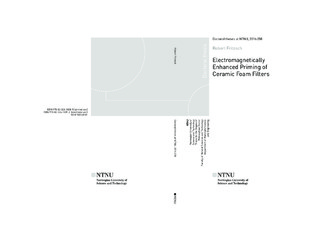| dc.description.abstract | Impurities in aluminium can cause detrimental physical and chemical inhomogeneity in the final products, as well as potentially catastrophic failures. Hence, one of the key aspects during production of aluminium and its alloys is to control the amount of inclusions/contaminants remaining within the metal after filtration, i.e. controlling the ‘Cleanliness’ of the produced material. The filtration step is the second stage of inclusion removal (after settling), and the last step of the melt treatment stage prior the casting.
In the filter-boxes used today the metal head is used to prime the filter by gravity, when mounting the filter in the filter-box below the metal level in the launder. If the filter is mounted far below the launder, the priming will be good, but then an extensive amount of metal needs to be drained from the filter-box after each cast (a single filter box typically contains 500-600 kg of sump metal by the end of each cast). In addition, the existing technology also involves significant manual handling of molten metal and hot filters, introducing a human factor, which increases the probability for HES related incidents and adds additional costs.
High Pores Per Inch (PPI) filters have proven to have excellent efficiency for inclusion removal; however, these types of filters, i.e. 50-80 PPI, are not commonly applied in industry. One reason that these filters are not used is that they cannot be effectively primed in many commercial cast house installations due to the excessive metal head required.
The electromagnetic (EM) priming technology is a patented innovative concept (US Patent nr. 20150322543), reinventing the fundamental concept of the filter-box by eliminating the need of preheating, extensive metal head and limitations to filter thickness. The main objective of the present work has been to investigate the effect of up scaling of the EM priming technology used for the priming of molten aluminium on Ceramic Foam Filters (CFF). Focus has been on different (i) coil designs (shapes and sizes), (ii) filter grades and thickness, and (iii) aluminium alloy systems. The final goal of the thesis was a ‘proof of concept’, by realizing the theory, design, construction and validation of the EM priming effect on high grade 23 inch CFFs, i.e. on a full industrial scale filter.
EM field modelling, analytical calculations and experimental validations were undertaken to estimate the shape effect of the coil (square versus round) on the shape of the magnetic field, and on the magnitude and direction of the induced Lorentz forces prior to construction of the coils. Lorentz force calculations were performed analytically, and the solutions verified by COMSOL® simulations and later validated by experimental observations. The inductive heating power were evaluated for all inductor sizes, and the Magneto Hydro Dynamics (MHD) induced by the Lorentz forces verified by COMSOL® simulations. Focus was placed on the formation of a meniscus, in order to evaluate the potential benefits of the effectively higher ‘gravity head’ to achieve priming of the CFFs.
In the present work the EM priming effect was investigated using laboratory scale round 4 inch and intermediate square 9 inch CFFs, as well as industrial pilot scale square 23 inch CFFs. Filters of various grades (30, 50 and 80 PPI) and at different filter thicknesses (50, 100 and 150 mm) was tested using 3 different alloys (A356, A3XXX and A5XXX). Batch reactors were designed for each filter size to mount from 1 to 3 filters in a stack, and used with newly designed and constructed round 4.7, square 12.2 and square 28.9 inch induction coils. These coils were used to investigate the EM priming by application of EM field strengths varying from 0.1 to 0.25 T. A practical approach to designing induction coils with maximized generation of Lorentz force, and the strongest magnetic fields, beginning with simple inductance calculations, is also presented. The dictum to achieve priming on high-grade cold filters, i.e. to use no preheating, was kept throughout the work.
The cleanliness of the metal after filtration of an EM primed CFF was investigated by two methods, i.e. (i) a purely theoretical approach using empirical mathematical models to estimate the filtration efficiency, and (ii) a method for quantification of the metal cleanliness by automated image acquisition and processing. The quantification of the melt cleanliness was conducted by a moving stage mounted on a light microscope and self-programmed macros by ImagePro® Plus 7, allowing for a less biased particle and inclusion count. The method has been successfully compared to a manually conducted cleanliness count, revealing a total error below 3%. The results of the automated image processing method have been used to validate the proposed mathematical models.
In the present work the ‘proof of concept’ has been successfully demonstrated by priming 3 stacked 50 PPI and a stack consisting of one 50 and one 80 PPI 23 inch industrial scale CFFs. A positive effect of the EM field on the priming ability of CFF without preheating was observed, and could be reproduced for every laboratory experiment, as well as for the industrial scale trials. The induced EM priming allowed priming of 150 mm thick high grade CFFs without application of preheating while using normal casting temperatures and less than the standard metal head. | nb_NO |
| dc.subject | Aluminium, Ceramic Foam Filter, CFF, Priming, Filtration, Induction, Coil design, Electromagnetism, Magneto Hydro Dynamics, MHD, CFD, FEM, Metal meniscus, COMSOL, Metal cleanliness, Melt quality, Automated image processing, Particle counting, ImagePro | nb_NO |
